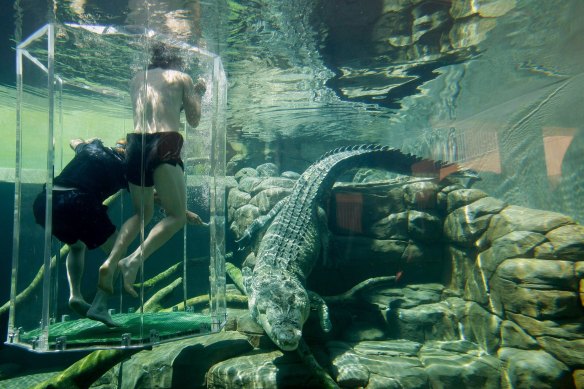Port guide: Darwin, Australia
Darwin is a multicultural, characterful small city that’s no longer merely a gateway to the Northern Territory’s national parks, but a destination in its own right.
Who goes there
Many regular ocean ships call in at Darwin on their way from South-East Asia to the South Pacific, usually via our east coast. The city is also a turnaround port for the many expedition companies that sail evermore popular Kimberley cruises, including APT, Coral Expeditions, Lindblad, Scenic, Seabourn, Silversea, Ponant and Travelmarvel.

Darwin’s cruise and waterfront precinct.Credit: Tourism NT
Sail on in
Darwin’s modest high-rises are first spotted at a distance, like a strange vision in a landscape of otherwise beaten brown earth and clawing mangroves. Humidity presses down as you stand by the ship’s railings. It’s not Australia’s most exciting sail-in, but it does provide a wonderful impression of the continent’s vastness and Darwin’s isolation.
Berth rites
Ships tie up at a sun-beaten quay grandly known as Fort Hill Wharf, from which a short walk takes you into a tin-shed terminal of no merit, apart from its smallness and efficiency. The good news is you can follow a short, covered walkway into the Waterfront precinct, which has shady parkland, places to swim, and a collection of restaurants and bars.
Before and after
If you haven’t been to Darwin before, stay a night before continuing onwards to surrounding national parks. Vibe Hotel Darwin Waterfront has comfortable rooms with pleasant views and is a short walk both from the cruise terminal and downtown Darwin. You’ll have plenty of restaurant choices nearby.
Going ashore
Central Darwin has heritage buildings, a Chinese temple and informative signboards, but won’t detain you long unless you shop along pedestrian Smith Street.
Get out to the botanic gardens and excellent Museum and Art Gallery of the NT, which covers natural history, Darwin history, and a compelling account of Cyclone Tracy, which wrecked the city in 1974. If you’re in town on a Thursday or Sunday evening in the dry season, Mindil Beach Sunset Market’s multicultural feast is a must.
Don’t miss
RFDS Tourist Facility on the far side of the Waterfront; you can walk from the terminal in 15 minutes. One part of this exhibit tells the story of the Royal Flying Doctor Service, while the other much more interactive part recounts the World War II bombing of Darwin by the Japanese. Interactive screens, virtual-reality goggles, holograms and sounds effects bring history – and the personal stories of those involved – alive.
Get active

Would you dare? Darwin’s iconic Cage of Death.Credit: Getty Images
Darwin’s humidity will dampen your enthusiasm for energetic walking and jogging, but the Esplanade and, further out, East Point provide plenty of space to roam. Charles Darwin National Park is within cycling distance and has numerous cycling trails. The Waterfront precinct has swimming areas safely behind stinger nets, as well as a wave pool. To get the adrenaline going, take a dip into the Cage of Death at Crocosaurus Cove and eyeball a saltwater crocodile.
Retail therapy
Darwin is a good place to buy Arnhem Land, Central Desert and Western Desert Indigenous arts and crafts from outlets such as the Aboriginal Fine Arts Gallery, Mbantua Gallery and Mason Gallery. For two other specialities of the region visit Paspaley Pearls, and Di Croco for handbags, belts and wallets made from crocodile skin.
Further afield
Shore excursions beyond town will take you to Territory Wildlife Park, the Adelaide River for a cruise to see its infamous “jumping” crocodiles, or Litchfield National Park, best known for its waterfalls and giant red termite mounds. Landscapes range from monsoon rainforest to sandstone escarpment. Don’t expect excursions to Kakadu National Park, which can’t reasonably be seen on a day trip.
Sign up for the Traveller Deals newsletter
Get exclusive travel deals delivered straight to your inbox. Sign up now.